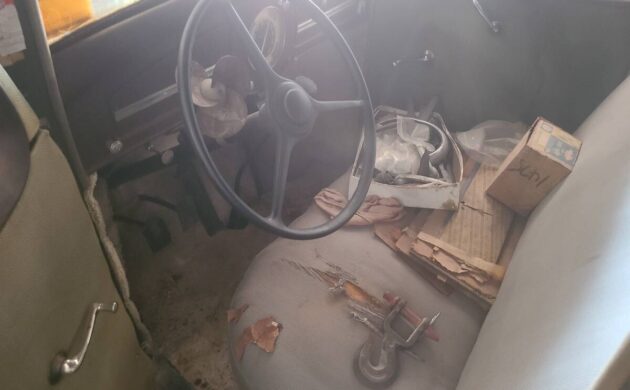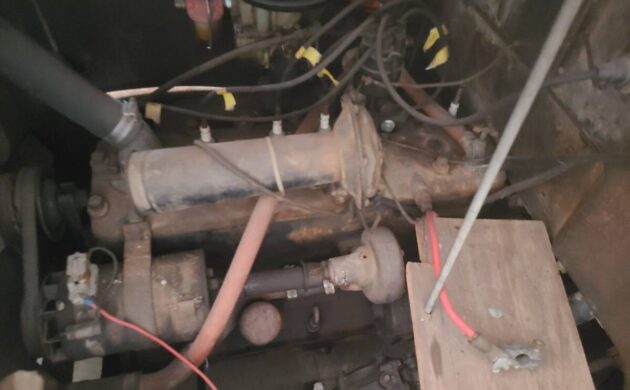One of the side effects of the Great Depression was its forced consolidation of the automobile industry. While there were dozens of reputable makers before the Black Thursday stock market crash in 1929, very few companies survived the financial turmoil. One of the smaller makers that struggled through that era was Graham-Paige. This 1937 Graham sedan for sale on Craigslist in Conway, South Carolina is one of the company’s more pedestrian products, but is a good chance for someone to add something different to their garage. Is this original car, which was on the road just 11 years ago, the type of car you would plunk down $9,500 for? Thanks to Pat L. for the tip!
Brothers Joseph, Robert, and Ray Graham were nothing if not enterprising. They started in the glass industry but soon sold that entity to what would become Libby Owens Ford. Then, it was off to produce truck conversion bodies for Model T chassis. They soon switched to Dodge power for their truck projects and eventually were bought out by Dodge. Now executives at Dodge, the brothers grew restless. They purchased the Paige-Detroit Motorcar Company in 1927 and began producing their own vehicles again. The company quickly gained a reputation for producing quality vehicles with unique styling. The biggest problem was resources. While the cars sold well in the early thirties, contracting out for the production of components cut into profits.
This was a problem that the Big Three didn’t suffer as much from, so their profit margins were larger in the depressed economy. The company soldiered on, even becoming pioneers in producing supercharged engines. By 1936, Graham was forced to enter an arrangement with Reo to produce bodies for their vehicles. The arrangement produced cars that weren’t as aesthetically pleasing as competitors and sales continued to decline. 1938 saw the introduction of the radically styled “Sharknose Grahams.” These, and the succeeding partnership with Hupmobile to produce cars using Cord body dies were all financial failures. The company stopped producing automobiles under the Graham name in 1940. Interestingly, the company survived the war years and returned to automobile production with Henry Kaiser under the Frasier name. When that went kaput, the monies left were invested in real estate. Their most famous property was Madison Square Gardens.
The 1937 Graham seen in this ad is one of the REO-bodied offerings. Sadly, it is not as eye-catching as some of Graham’s other designs produced that decade. On the plus side, it is advertised as having come out of a large collection purchased by the seller and still wears its original paint and interior. The car last ran eleven years ago, and the engine still turns over with a new battery. The car is also said to roll freely and easily. While there is surely some surface rust here and there, it is also advertised as being rust-free.
The downside to owning an orphan make is a lack of aftermarket support. That is often made up for by support from clubs dedicated to the automaker and the message boards on the internet dedicated to that make. We are also on the cusp of different ways to solve the problem of out of production spare parts. With new technologies, parts will be able to be remanufactured rather inexpensively in comparison to finding a machine shop to make them. One just has to have the courage to take a chance on an uncommon car.
The seller feels that this car would be fairly easy to get back on the road given its condition. With a fuel system cleanout, a thorough going through of the braking system, and a new set of tubes and tires that would likely be the case. Hopefully, this rather plain but interesting Graham will find its way into the garage of someone who will fix it up and enjoy it. Graham wasn’t a major make, but one that still needs to be represented at car shows today.
Have you ever owned an orphan automobile? Would you take a chance on one today? Please share your experiences and let us know your thoughts in the comments.







Might be difficult to find parts but in the end you’d have the only one at the Friday night cruise. Wish I was younger and had the money and space. Unique car.
Love to have an “orphanage” with one of each of the forgotten marques. All in operating condition.
As I have stated before I LOVE cars of all types and have a few my self. I also love Street Rods but I would hate to see this car fall in the hands of a Street Rodder in the original condition that it exemplifies. PLEASE somebody buy this car and restore it.
Bill
Yes, I been a kaiser guy for a long time and with the Kaiser Club and NAPA you can find just about anything you need to keep the car running and going.
Yes I know that everybody’s going to hate me but this car is begging to be a hot rod. It’s very cool don’t touch the body it’s perfect the way it is just put a more modern drivetrain underneath it and drive it around. I want something that I can drive everyday and also look good doing it. Something like this is perfect. You don’t need to cut it all up to make it a nice car.
I do believe this is a 1935 Graham sedan. 1937 body style is totally different. Still a very cool car that should roaming the roads in some form.
It really doesn’t look like it needs much restoration. Why not leave well enough alone, make it safe and reliable to take out once in a while? To me this would a neater car in present condition than a comparable Ford or Chevy restored to perfection.
Orphan cars are not hard to find parts for. Most of the time, other than engine parts, they bought from the same suppliers that many other makes bought from. The trick is knowing what interchanges. That’s where the clubs come in.
Hollander parts-interchange books are most valuable, and older ones are being reprinted.
I’ve never been enamoured with the commonplace and I relish automotive history such as the Graham story. The price is right, and if I had the room, I’d buy it, yes.
Candy apple red be my choice for color
Regarding the reference to the Graham supercharger: it was developed by Floyd Kishline. When Graham discontinued auto production, he became chief engineer at Nash-Kelvinator and retired from American Motors.